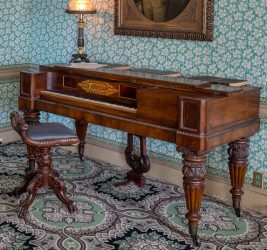
Piano Forte
c.1821-1836
Rosewood, satinwood, ivory, brass
New York, Dubois and Stoddart
JJ.1958.146
This piano is a creation of early 19th century piano makers Dubois and Stoddart, a New York manufacturing firm. William Dubois & Robert Stoddart began manufacturing pianos as a firm in 1821.
Stoddart was a very skilled manufacturer from London, where he learned the piano craft from his uncle. Dubois was a wealthy merchant and importer who supplied the capital for the partnership. The pair were one of the first American firms to compete successfully with the English importers, where the craft was far more popular.
In the records of the Jay family correspondence, there is mention of the piece. In a letter between Maria B. Jay (1815-1881) and John Jay II (1817-1894) the latter writes her brother the directions to go to Dubois and Stoddart to find a man there to tune her piano.
The piano may be the one acquired by Maria in 1832, when she was seventeen years old. In June of 1832, when Maria Jay, William Jay’s daughter, was 17 years old, William made a request of his nephew John Clarkson Jay in New York:
It is to ask the favour of you to buy a Forte Pianno for Maria. She wishes one of a sweet but stronger tone than her aunt Banyer’s. The case to be of mahogany without any brass or gilded ornament whatever, but in other respects neat & well finished. “
In October, young Sarah Louisa wrote to her Aunt Banyer to tell her how much Maria enjoys the piano that she had given her. “You do not know my dear Aunt what an amusement the pianno [sic] gives us. I heard Maria say the other day that “Aunt Maria could not have given her a more acceptable present …she practices every morning and often in the afternoon… .” Perhaps Maria Banyer paid for the piano that William ordered from New York as a gift for her niece.
The keys are made from ivory and brass; there are 43 white keys and 30 black. The black keys are painted brass. Most pianos today have 88 keys compared to the 73 on the Jay’s piano.
Pianos originally had sixty keys for the five octaves (12 notes for each octave), but composers began to write music beyond the octaves available on the piano and so more were added. In the late 1800s, Steinway capped piano design at 88 key because composers weren’t writing past the notes available; the human ear doesn’t register sound too far past the range available with 88 keys.
Popular music from the time would be played; possibly Chopin (who himself like to play in parlors). In the U.S., hymns and folk songs were popular. The piano would have been played at parties or small gatherings, and simply played for amusement as families spent most their time together in the parlor. Learning a musical instrument became a key part of girls’ educations.
You may view the Object of the Day Archives HERE
